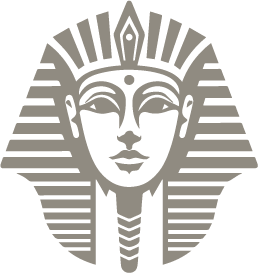Turn of the Century Middle East—Part-1
 Turn-of-the-Century Middle East: A GBD Microsite
Turn-of-the-Century Middle East: A GBD Microsite

Lithograph above by Charles Hague | Source: The New York Public Library via Old Book Illustrations.
Stylized Egyptian Textile Patterns
The History of Garments in Ancient Egypt
(Source: Crystal Links):
 Fashion for men and women, rich or poor, changed very little over the centuries in Ancient Egypt. The clothing worn by men and women was made of linen, were simple in design, and lightweight for the hot climate. All men, from the tomb worker to the pharaoh, wore a kind of kilt or apron that varied in length over the years, from halfway above the knee, to halfway below it. It was tied at the front, folded in at the side, or in two knots at the hips. A sleeved, shirt-like garment also became fashionable.
Fashion for men and women, rich or poor, changed very little over the centuries in Ancient Egypt. The clothing worn by men and women was made of linen, were simple in design, and lightweight for the hot climate. All men, from the tomb worker to the pharaoh, wore a kind of kilt or apron that varied in length over the years, from halfway above the knee, to halfway below it. It was tied at the front, folded in at the side, or in two knots at the hips. A sleeved, shirt-like garment also became fashionable.
Women wore straight, ankle-length dresses that usually had straps that tied at the neck or behind the shoulders. Some dresses had short sleeves or women wore short robes tied over their shoulders. Later fashions show that the linen was folded in many tiny vertical pleats and fringes were put at the edges. Wealthy people wore sandals made of leather that had straps across the instep and between the first and second toes.
The Egyptian climate with its hot summers and mild winters favored light clothing made from plant fibers, predominantly linen and in Roman times occasionally cotton, an import from India. Wool was used to a lesser extent, and seldom by Egyptians proper. Small amounts of silk were traded to the eastern Mediterranean possibly as early as the second half of the second millennium BCE and traces of silk have been found in Egyptian tombs.
 Animal skins, above all leopard skins, were sometimes worn by priests and by pharaohs in their role as first servants of the god. Such outfits were found in Tutankhamen’s tomb and were depicted quite frequently on the walls of tombs. At times kings and queens wore decorative ceremonial clothing adorned with feathers. The manufacture of clothes was apparently mostly women’s work. It was generally done at home, but there were workshops run by noblemen or other men of means.
Animal skins, above all leopard skins, were sometimes worn by priests and by pharaohs in their role as first servants of the god. Such outfits were found in Tutankhamen’s tomb and were depicted quite frequently on the walls of tombs. At times kings and queens wore decorative ceremonial clothing adorned with feathers. The manufacture of clothes was apparently mostly women’s work. It was generally done at home, but there were workshops run by noblemen or other men of means.
Basic garments with minor variations accounted for fashion, social status and wealth did not change fundamentally throughout Egypt’s history. Very little sewing was done. The cloth was wrapped round the body and held in place by a belt. Its color was generally whitish, in contrast to the colorful clothes foreigners wore in Egyptian depictions, although dyed cloth was not unknown.
Everyday clothing was mostly undecorated, though pleating was known since the Old Kingdom, when some dresses of upper class Egyptians were pleated horizontally. In the New Kingdom the pleats were often vertical, but pleating could be quite intricate. A Middle Kingdom piece of clothing displays three different types of pleating: one part is pleated with pleats a few centimetres apart, another with very narrow pleats and a third part is chevron-patterned, with horizontal and vertical pleats crossing each other. How the pleating was done is not known, but it is generally supposed to have been very labour intensive.
 The length of the the kilts varied, being short during the the Old Kingdom and reaching the calf in the Middle Kingdom, when it was often supplemented with a sleeveless shirt or a long robe. Linen kalasiris, New Kingdom; Source: University of Indiana website The robes worn by both sexes in Egypt were called kalasiris by Herodotus. Material and cut varied over the centuries, though the cloth of choice was always linen. The kalasiris women wore might cover one or both shoulders or be worn with shoulder straps. While the top could reach anywhere from below the breast up to the neck, the bottom hem generally touched the calves or even the ankles. Some had short sleeves, others were sleeveless. The fit might be very tight or quite loose. They were often worn with a belt which held together the folds of cloth.
The length of the the kilts varied, being short during the the Old Kingdom and reaching the calf in the Middle Kingdom, when it was often supplemented with a sleeveless shirt or a long robe. Linen kalasiris, New Kingdom; Source: University of Indiana website The robes worn by both sexes in Egypt were called kalasiris by Herodotus. Material and cut varied over the centuries, though the cloth of choice was always linen. The kalasiris women wore might cover one or both shoulders or be worn with shoulder straps. While the top could reach anywhere from below the breast up to the neck, the bottom hem generally touched the calves or even the ankles. Some had short sleeves, others were sleeveless. The fit might be very tight or quite loose. They were often worn with a belt which held together the folds of cloth.
They were sewn from a rectangular piece of cloth twice the desired garment length. An opening for the head was cut at the centre of the cloth, which was then folded in half. The lower parts of the sides were stitched together leaving openings for the arms.
Women’s dresses were at times ornamented with beads. They covered the breasts most of the time, though there were periods when fashion left them bare. Circular capes date back as far as the Old Kingdom. They were generally made of linen and had an opening for the head cut at the centre. They were often dyed, painted or otherwise decorated and covered little more than the shoulders. Shawls were sometimes worn during the New Kingdom.

